What is ring rot of potatoes and methods of dealing with it
Potato tubers rich in water and starch are a favorable environment for the development of bacteria and fungi. Potato diseases, in particular ring rot, can completely destroy the crop. For this reason, they begin to fight the disease when the first signs are found.
In the article, we will describe in detail what ring rot of potatoes is, we will give a description of the symptoms of the disease and how to treat it.
The content of the article
Description of the disease
Ring rot of potatoes is dangerous because it affects both the tops and tubers... Affected potatoes begin to rot before harvesting. And healthy tubers become infected through the infected tops when they are dug up.
Characteristic
Ring rot is a bacterial disease, common in all areas where the crop is grown.
You can detect the disease by cutting the tuber... If the potato is infected, a vascular ring is visible under the skin. The fabrics in the area of the ring are soft and yellow-brown. When pressed, light yellow mucus emerges from the affected tissues.

With the development of the disease, rot passes to neighboring tissues, covering the entire tuber... The flesh of a potato rots and turns into a slimy substance with an unpleasant odor.
Attention... The disease develops slowly. At the initial stages of development, the pathogen can only be identified by laboratory methods.
If you do not detect the problem in time and do not take action, crop losses can be 40-50%.
Infected bushes dig up and destroy... It is no longer possible to cure these plants. Therefore, prevention plays a special role in the fight against infection.
Development conditions
Harmful bacteria thrive at moderate temperatures (from + 20 ° С) and high humidity. In heat and drought, the development of the disease is suspended. The main source of infection preservation and its transmission to new generation tubers is already infected tubers.
Causative agent
The causative agent of the disease is bacteria... It is noteworthy that they do not survive in the soil and are not able to winter in it. However, they remain viable in vegetable stores, on plant residues, in garden tools. But the main source of infection is infected tubers placed in storage.
The pathogen is capable of being dormant for several generationsuntil the right conditions for development come. Therefore, even from outwardly healthy tubers, diseased plants are sometimes obtained.
It can be useful:
What to do if the potatoes inside are empty
Transmission methods
Tubers become infected with bacteria during growth, in the early stages of tuberization... The causative agent of the disease from the vessels of the diseased bush through the stolons penetrates into the new crop potatoes.
Another way bacteria can spread is through contamination during harvesting.... The causative agent of the infection enters the surface of the tuber through contact with infected tops, cut diseased potatoes or tools used during harvesting.
During storage, healthy tubers can also become infected by contact with sick... Especially if the former have damage to the skin, scratches or cuts. For this reason, all damaged potatoes are stored separately from the main crop and processed first.
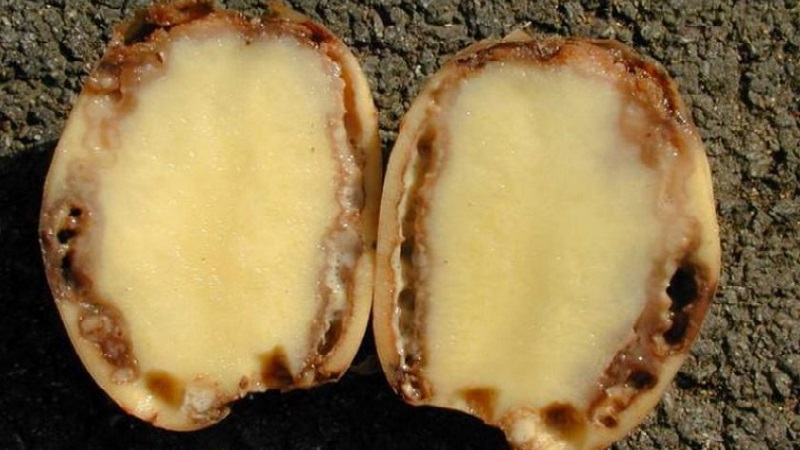
Forms of the disease
Ring rot develops in two forms: pitted rot and ring rot proper.
Pit rot is the primary form of the disease... It develops when an infection gets on the skin of a potato during harvesting (by contact with diseased tops or tubers).
In this case, rounded oily yellow spots 2-3 mm in size appear on the tubers during storage. Gradually they grow up to 1–2 cm in diameter. At first, no symptoms of the disease are visible. The disease manifests itself only in March-April.
Attention... When the temperature rises (+ 18 ... + 20 ° C), the development of pitted rot intensifies.
If such tubers are not removed during preparation for planting, then the disease will progress and spread to young tubers.
The second form of the disease is actually ring rot.... It manifests itself as necrosis of the vascular ring on a cut of a potato. The infection spreads from infected tubers planted in spring.
Signs of potato infestation
It is possible to understand that planting needs help, both by cutting the tubers, and by the appearance of the bush.
Advice... Inspect bushes when hilling and weeding. The first signs of infection become visible during the flowering period.
Disease is evidenced by wilting of one or two stems in the bush... Their fall to the ground is a characteristic sign of ring rot. Brown spots appear on the tips of the leaves of wilted stems.
Important... The causative agent of ring rot, moving from the infected tuber along the roots to the stems, causes clogging of blood vessels. As a result, nutrients do not enter the tops and it withers.
If the tubers are still weakly affected by the infection, then they are no different from healthy ones in appearance. But on the cut, the vascular ring with yellowed and softened tissues is already visible.
The photo below shows what the tops of an infected bush looks like and what a tuber looks like in the initial phase of infection. As the disease develops, the potato is completely destroyed and turns into a slimy mass.
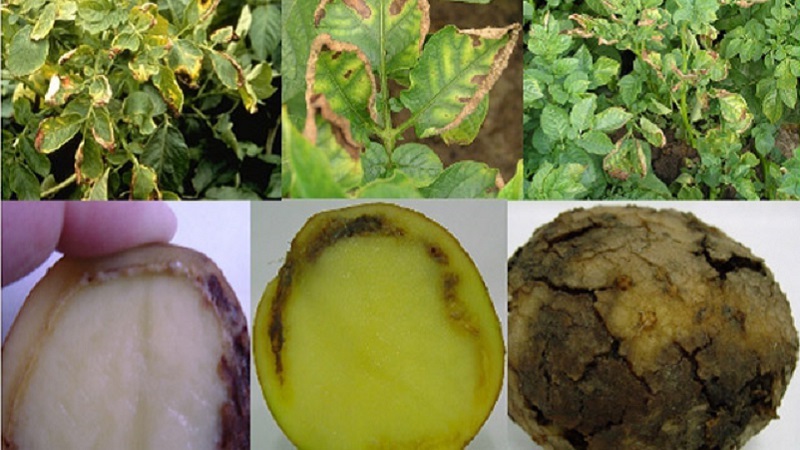
We list the main signs of the onset of the disease:
- yellow or brown cut rings close to the skin;
- release of a mucous mass when pressing on a rotten tuber;
- yellowing and curling of potato tops;
- lodging of several stems in the bush, while the stems are poorly removed and gradually die off;
- planting highly infested material leads to dwarf and poorly developed seedlings, the stems of such plants are thin, and the leaves are small and close to each other.
Causes of decay
If diseased tubers are the source of infection, then the disease develops especially quickly.... Bushes wither starting from the top due to lack of moisture. Moisture does not reach the top of the bush due to vascular blockage caused by bacteria.
As a rule, only individual stems wither on the bush. In addition, bacteria release toxins, which also contributes to wilting.
The causative agent of ring rot penetrates into young tubers from the affected stems through stolons... Also, tubers become infected through mechanical damage during harvesting and when injured potatoes come into contact with infected tops.
Important... Wet weather conditions combined with mild temperatures increase the severity of the disease. The bushes themselves wither slowly. High temperatures and dry weather are unfavorable for the development of bacteria, but the green part of the infected bush withers quickly.
The main source of the causative agent of ring rot is tubers and plant debris.... The pathogen does not persist in the soil. The spread of the disease occurs during harvesting and when diseased tubers enter the mass of healthy ones during storage.
Control measures
Among the measures to combat the scourge allocate folk remedies, biological and chemical preparations.
Folk remedies
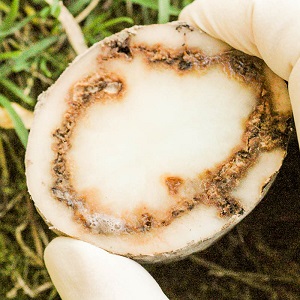 Insofar as sowing infected tubers is the main route of infection, then the main task is to prevent diseased specimens from entering the inoculum.
Insofar as sowing infected tubers is the main route of infection, then the main task is to prevent diseased specimens from entering the inoculum.
Warming up in spring will help identify infected tubers... The seed is kept warm for three weeks (at a temperature of + 15 ... + 18 ° C). In a warm environment, bacteria begin to develop actively and appear as foci of rot on the peel. With a close inspection, it will not be difficult to identify and remove infected specimens.
Compliance with the rules of crop rotation allows to successfully combat the spread of the disease... Changing the planting site every year heals the soil and allows for a healthy crop.
Gardeners with experience used to combat bacterial and fungal diseases, sowing green manure... This measure is also effective for ring rot. Sowing oats, rye, wheat, barley, corn and tobacco as green manure helps to fight the growth of bacteria and fungi.
Important... Sowing green manure in a potato field immediately after harvesting the potato in the fall and before planting it in the spring will reduce the activity of pathogenic bacteria and fungi.
Sow siderates immediately after digging up the potatoes... At the same time, fast-growing crops are chosen that provide a sufficient amount of green mass before the onset of cold weather.
In early spring, the area for potatoes is planted with mustard or oats.... Before sowing potatoes, the siderates are mowed, the earth is loosened and mixed with plant residues. Saprophytes developing in the soil inhibit the development of bacteria.
Read also:
Biological
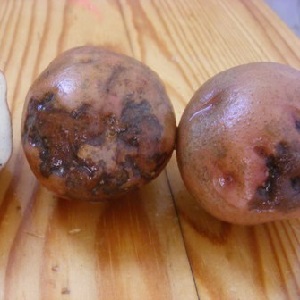 From biological products against the causative agent of ring rot, use "Gamair"... It is a biological bactericide intended for the treatment and prevention of both bacterial and fungal diseases of plants.
From biological products against the causative agent of ring rot, use "Gamair"... It is a biological bactericide intended for the treatment and prevention of both bacterial and fungal diseases of plants.
The drug is used in summer when watering plantings and in autumn - to protect tubers... If the autumn is dry, then two weeks before harvesting, the potatoes are watered with a solution of the drug (2 tablets per 50 liters of water).
If you store washed potatoes for winter storage, you can also add Gamair to the water while washing. Or spray the tubers with the drug solution before drying.
Chemical
Treatment of seed potatoes helps to get rid of bacteria that cause rotting of tubers fungicides, for example, such drugs as "Quadris", "Maxim Kvatro", "Uniform". They are based on the active ingredient azoxystrobin, a contact and systemic fungicide.
All tools used in harvesting are also treated... As a disinfectant solution, agents containing alcohol, chlorine, kerosene are used. A dark pink solution of potassium permanganate and a 5-10% solution of vitriol also have a disinfecting effect.
Is it possible to eat affected potatoes
Tubers in which the disease has just begun to develop, are not dangerous to humans and are quite suitable for human consumption. In such potatoes, the dark ring under the skin is not yet pronounced and the pulp has not lost its taste.
Potatoes with strong signs of damage, a pronounced unpleasant odor and soft mucous pulp can no longer be eaten.
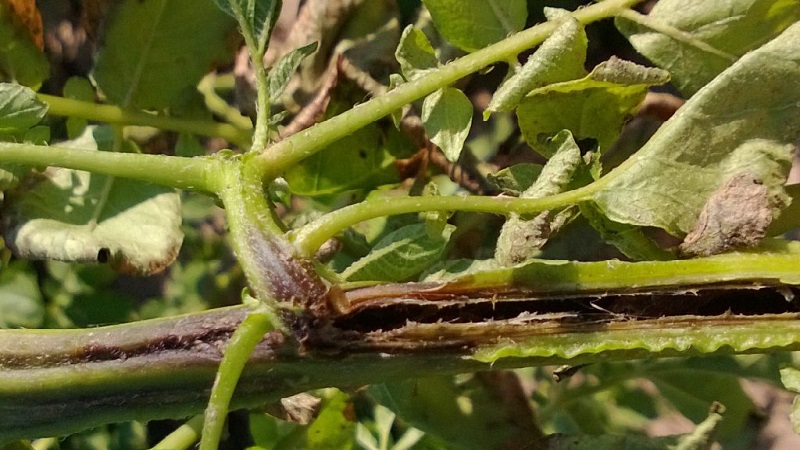
Prevention measures
The following agrotechnical techniques will help prevent plant damage:
- The most effective means of prevention is the planting of zoned resistant varieties. Early potato varieties are most prone to ring rot.
- The main source of the spread of the disease is affected tubers. Therefore, it is important to obtain healthy seed material, which primarily depends on the observance of agricultural cultivation techniques.
- Periodic inspection of plantings during growth and development. Identification and removal of diseased bushes.
- Compliance with the rules of crop rotation. Potatoes are planted in their original place no earlier than 3-4 years later.
- Prolonged drying of potatoes before storing them in storage for two weeks.After this time, all potatoes are examined and specimens with signs of infection are removed.
- Mowing and removing potato tops from the field 1-2 weeks before digging reduces the likelihood of contamination of healthy tubers from contact with infected greens.
- Disinfection of the cellar before storing vegetables for winter storage.
- Germination of seed material with subsequent identification and removal of diseased tubers.
The varietal qualities and resistance of potatoes to diseases decrease when non-compliance with the technology of cultivation.
Following these preventive measures will help you prevent the spread of infection. and keep the harvest for many months.
Conclusion
A disease of potato tubers, such as ring rot, can cause serious damage to potato stocks during storage. Therefore, it is imperative to fight the disease.
Observance of crop rotation, the use of proven seed material, and the choice of varieties resistant to bacterial rot will help preserve the harvest and prevent the development of the disease.